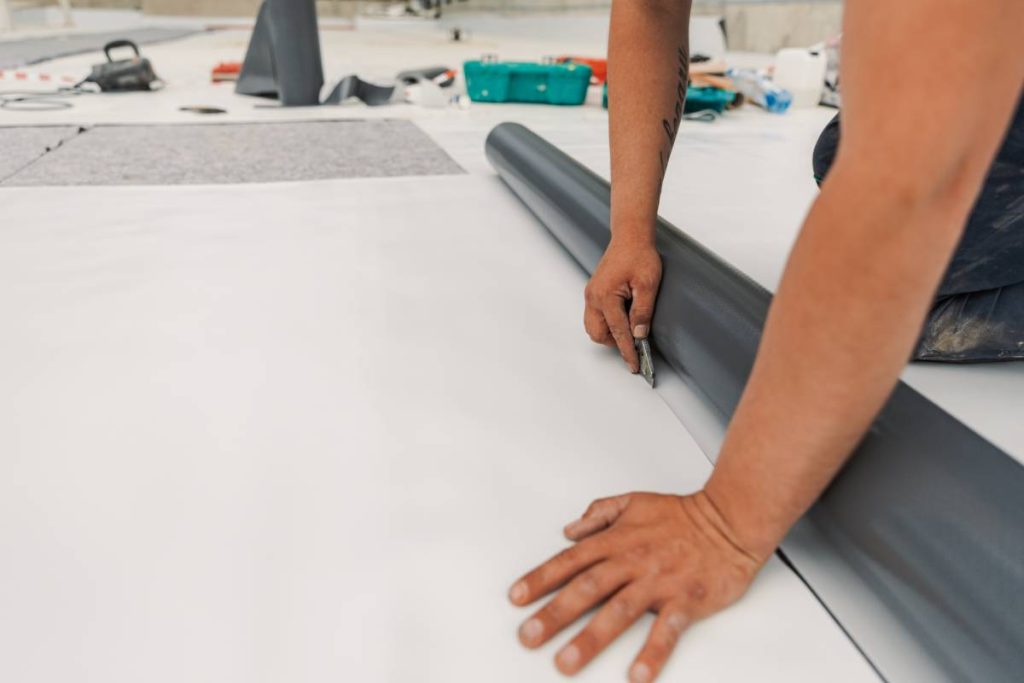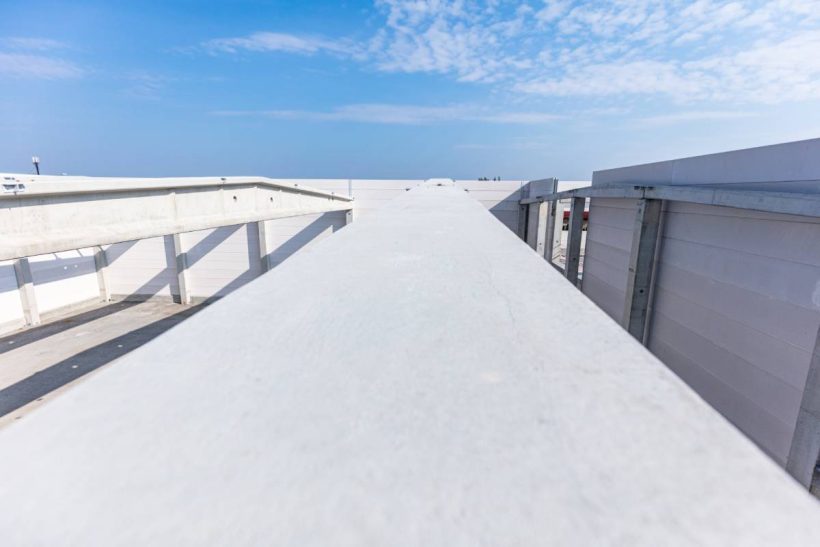TPO roofing, short for Thermoplastic Polyolefin, is a budget-friendly rubber roofing option commonly found on commercial structures. Made mainly from recycled rubber, TPO comes in rolls with seams fused together using heat.
If you’re thinking about using TPO or other rubber roofing for your house, it’s crucial to understand that it’s best suited for flat roofs or those with minimal slopes. While TPO roofing can be cost-effective, it comes with its own set of advantages and disadvantages. In this guide, we’ll delve into those aspects, along with typical costs and material prices associated with TPO roofing.
Related article:
What is TPO roofing?
TPO roofing stands for Thermoplastic Polyolefin roofing, which is a type of single-ply roofing membrane that is commonly used in commercial and industrial buildings. It’s gaining popularity because of its durability, energy efficiency, and ease of installation.
This type of roof typically lasts between 15 to 30 years, depending on various factors such as climate, installation quality, maintenance, and the thickness of the membrane. Generally, a TPO roof installed with high-quality materials and proper installation techniques can last closer to the upper end of that range, while factors like severe weather conditions or lack of maintenance may reduce its lifespan. Regular inspections and timely repairs can help extend the longevity of a TPO roof.
Let’s break down what TPO roofing is and why it’s becoming a top choice for many building owners.

What is TPO Roofing Made of?
TPO roofing is made from a blend of polypropylene and ethylene-propylene rubber, reinforced with polyester. This combination creates a flexible and durable membrane that can withstand various weather conditions.
Pros and Cons of TPO Roofing
Pros:
- Cost-Effective: TPO roofing is generally more affordable compared to other roofing materials like PVC or EPDM, making it an attractive option for budget-conscious building owners.
- Energy Efficiency: TPO roofs come in light-coloured options that reflect sunlight, reducing the need for air conditioning and lowering energy bills.
- Durability: TPO membranes are resistant to UV radiation, ozone, and chemical exposure, offering long-term protection for your building.
- Easy Installation: TPO roofing is lightweight and can be installed quickly, saving on labour costs and minimizing disruption to your operations.
- Flexibility: TPO membranes can expand and contract with temperature changes without cracking or tearing, making them ideal for areas with fluctuating weather conditions.
- Environmentally Friendly: TPO roofing is often made from recycled materials and is recyclable, making it a more sustainable choice compared to some other roofing materials.
Cons:
- Susceptible to Punctures: While TPO roofing is durable, it can be prone to punctures from sharp objects, potentially leading to leaks if not addressed promptly.
- Limited Color Options: TPO roofing is primarily available in white and light-coloured options to maximize energy efficiency. This limitation may not suit all aesthetic preferences.
- Quality Variability: The quality of TPO roofing can vary depending on the manufacturer and installation practices. It’s essential to choose reputable suppliers and contractors to ensure the longevity and performance of the roofing system.
- Warranty Issues: Some TPO roofing warranties may have limitations or exclusions, so it’s crucial to understand the terms and conditions before installation to avoid potential issues down the line.
- Not Suitable for Steep Slopes: TPO roofing is best suited for flat or low-sloped roofs. It may not be suitable for structures with steep slopes due to potential water drainage issues.
Overall, while TPO roofing offers numerous benefits such as affordability, energy efficiency, and durability, it’s essential to weigh these against potential drawbacks and consider factors like installation quality and warranty coverage before making a decision.

How is TPO Roofing Installed?
TPO roofing is typically installed in one of three ways:
- Mechanically Attached: The membrane is fastened to the roof deck using screws and plates.
- Fully Adhered: The membrane is glued directly to the roof deck using a special adhesive.
- Ballasted: The membrane is loose-laid over the roof deck and held in place by ballast, such as gravel or pavers.
Maintenance of TPO Roofing:
While TPO roofing is relatively low maintenance, regular inspections are essential to ensure its longevity. Here are some maintenance tips:
- Keep it Clean: Regularly remove debris, leaves, and other materials from the roof surface to prevent clogging of drains and damage to the membrane.
- Inspect for Damage: Check for punctures, tears, or seam separations, especially after severe weather events.
- Address Issues Promptly: Any damage should be repaired promptly to prevent water infiltration and further damage to the roof structure.
Why do you need TPO roofing?
You might choose TPO roofing for several reasons:
- Affordability: TPO roofing tends to be more cost-effective than other options like PVC or EPDM, making it attractive for budget-conscious building owners.
- Energy Efficiency: TPO roofs come in light-coloured options that reflect sunlight, reducing the need for air conditioning and lowering energy bills.
- Durability: TPO membranes are resistant to UV radiation, ozone, and chemical exposure, offering long-term protection for your building.
- Ease of Installation: TPO roofing is lightweight and can be installed quickly, saving on labour costs and minimizing disruption to your operations.
- Flexibility: TPO membranes can expand and contract with temperature changes without cracking or tearing, making them ideal for areas with fluctuating weather conditions.
- Environmental Benefits: TPO roofing is recyclable, making it a more sustainable choice compared to some other roofing materials.
Overall, TPO roofing provides a balance of affordability, durability, energy efficiency, and ease of installation, making it a popular choice for commercial and industrial buildings.

How much does TPO roofing cost?
TPO roofing, typically sold in rolls, is commonly priced by squares, each square covering 100 square feet of roofing area. So, when estimating TPO roofing costs, contractors often quote prices in squares. The price of TPO roofing material can vary significantly, ranging from $3.50 to $14.00 per square foot. This means that a single square of TPO roofing could cost anywhere from $350 to $1,400, reflecting the various thickness options available for TPO roofing.
TPO Roofing Cost Estimation:
- Average Cost: $12,000
- Highest Cost: $18,000
- Lowest Cost: $6,000
Additional Costs for TPO Roofing Installation:
In addition to the roofing material, installing a TPO roof requires other materials like insulation and flashing to ensure proper installation and protection against leaks.
- TPO Insulation: Insulation, which goes underneath the roofing, is crucial for regulating temperature and protecting the building. Typically, insulation for TPO roofing ranges from $1.50 to $3.50 per square foot.
- TPO Flashing: Flashing is essential to prevent water from seeping into the building’s interior, especially along seams and corners. The cost of flashing pieces typically falls between $5 and $50, depending on the type and amount needed.
- TPO Attachment System: The method used to attach the TPO roofing to the building also affects costs. There are three main attachment methods:
- Ballasted Attachment: Utilizes rocks or pavers to weigh down the roof.
- Fastened Roof: Involves using screws to secure the rubber roof to the underlayment.
- Attached Roof: Requires glue to fasten the rubber roof to the underlayment.
The cost for each attachment method varies:
- Ballasted: $1.50 – $2.50 per square foot for 0.45 mil; $2.00 – $2.50 per square foot for 0.65 mil.
- Fastened: $2.00 – $3.00 per square foot for both 0.45 mil and 0.65 mil.
- Attached: $2.75 – $3.50 per square foot for 0.45 mil; $2.50 – $3.50 per square foot for 0.65 mil.
These figures provide a breakdown of TPO roofing costs, including material prices and attachment methods, to help estimate the total expenses involved in TPO roof installation.










